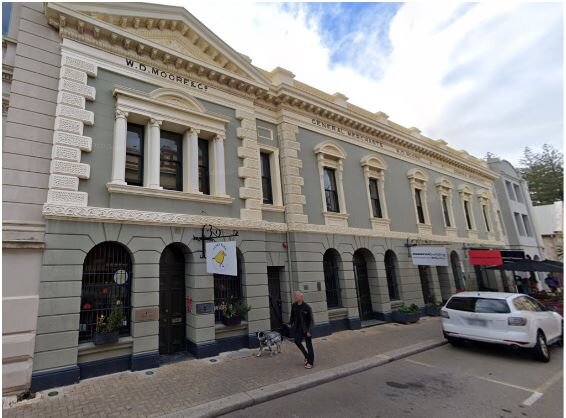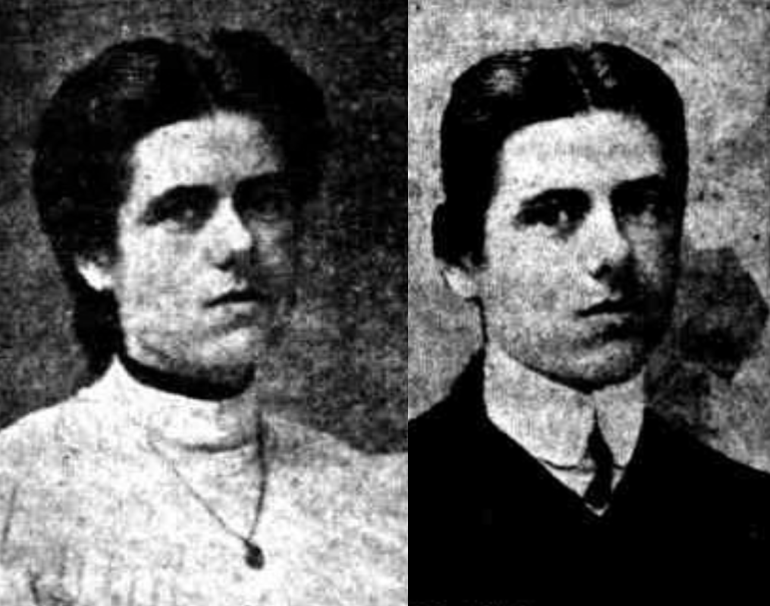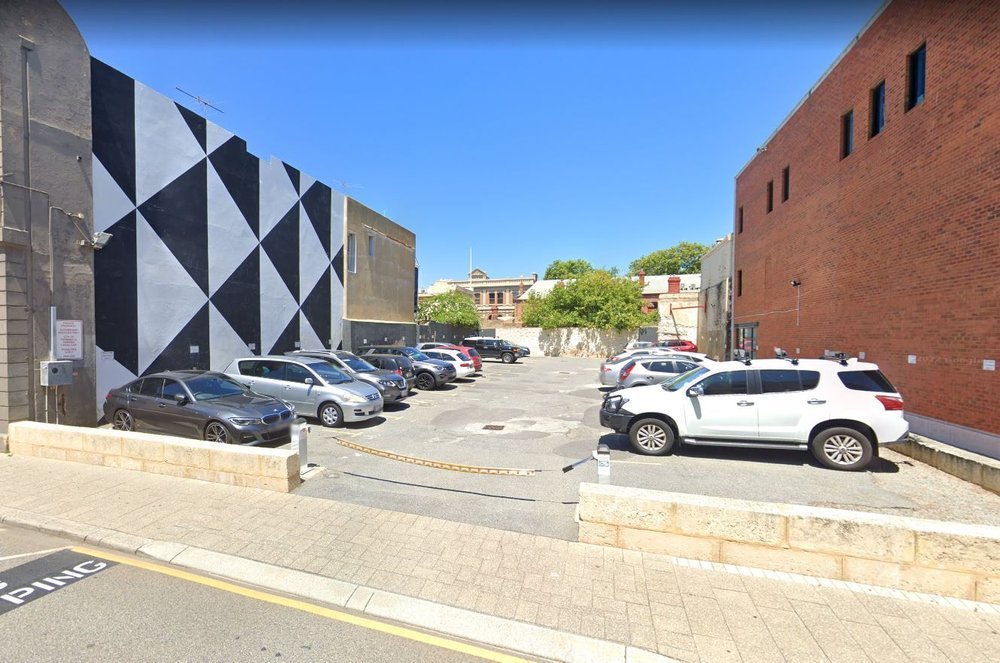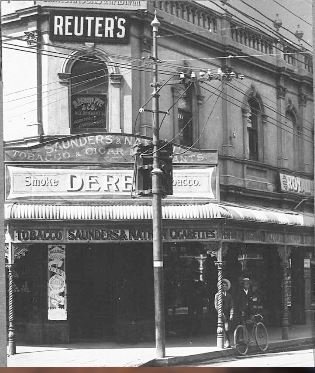20-28 Henry St (was 32-40 pre 1938), and 36-40 (was 56-58) High Street, The Rialto, Marich Buildings
A two storey series of shops that face both Henry and High Sts, constructed c. 1897 as offices and shops. The design by architect F W Burwell was originally known as the Rialto, imprinted in stucco across the corner and features a decorative parapet with small arched piers.
A single storey stone shop/ residence was on the site prior to 1884, most likely the Royal Hotel (1844 Chauncey-Snell survey).
1906 The Rialto- with Saunders and Nathan in the corner shop, were the premier hairstylists in Fremantle at this time. They also sold tobacco and were the chief suppliers of cigars.
1910 A Miss Meadley, employed at Messrs Saunders and Nathan’s Tobacco Shop, in Fremantle, recognised something in a photograph put into the papers asking for information on missing girl Margaret Bale. She cut the picture out of the paper, encircled the head and neck with a piece of paper, and saw a likeness to ‘Martin Able’, who she remembered. She then communicated her impressions to the authorities…
Nicholas Marich was the owner from 1948 to 1991 and the buildings became know as the 'Marich Buildings’.
In the late 1970s part of the building was a boarding house.
In 1994, alterations were carried out by Ralph Hoare Architect.
2002 under renovation K & S Renovations
2007 Tatoo Parlour
OCCUPANTS
Lot 80 & 81 owners:
1829 - 1837 Steele, W R
1855 - 1859 Hammersley
1876 - 1877 Brockman, H
1878 - 1879 Brockman, E
Land owned by the Brockmans until c 1948
No. 20 (was 32 pre 1938)
1899 Stephens William, restaurant
1900 Teaquer & CO. (E.), restaurant
1904 Jackman, T J, restaurant
1903- 1905 Halleen, Mrs E E, Alhambra cafe and Tearooms
1906 - 1908 Banach Steve, restaurant
1912 - 1919 Alhambra cafe
1912 - 1917 Perara, Joseph
1918 Prior, Mrs M
1919 Wilson, Mrs Nellie
1920 Jones, Mrs May, lodge house
1921 - 1926 Bradford hostel (Benjamin Lorner, proprietor)
1925 Fremantle Boys’ Club
1926 - 1930 Sanitarium Health Food Co.
1927 - 1938 Buffalo Lodge
1933 - 1934 Hollis, E, hardware merchant
1940 - 1941 Thomson J Bowe, plumber
1944 - 1947 Grayson & Co. shipwrights & contractors
1949 Roby & Co A, sheet metal workers
No. 22 (was 34 pre 1938)
1918 - 1919 Alhambra cafe
1918 Prior, Mrs M
1919 Wilson, Mrs Nellie
1920 Jones, Mrs May, lodge house
1924 Murphy, David, tailor
1926 - 1927 Knapp, Jack, tailor
1938 - 1939 Buffalo Lodge
1940 - 1941 Thomson, J Bowe, plumber
1941 - 1943 Vacant (upstairs) Miller Edward, apartments
1944 - 1949 (upstairs) Petitt Robert, apartments
1949 Roby & Co A, sheet metal workers
No. 24 (was 36 pre 1938)
1899 Webster, W S, confectioner
1899 - 1906 Ashton & Badham, painters
1907 Lane, A E, painter
1911 - 1917 Hughes & Bishop, sign writers
1918 - 1919 Martinelli, Angelo
1921 - 1922 The Fremantle Herald
1923 - 1925 Allen, Lt A W
1926 - 1938 Churcher & Co, F W (W H Sharp, prop), forwarding agents
1940 - 1941 Thomson, J Bowe, plumber
1949 Roby & Co A, sheet metal workers
No. 26 (was 38 pre 1938)
1913 - 1914 Otrovski, Isaac, dealer
1915 - 1916 Moscow, J, tailor
1917 Paoli, Pompeo, sailmaker
1918 Hughes & Bishop, sign writers
1919 - 1920 Bishop, Henry J, sign writer, painter, decorator, etc.
1921 - 1946 Churcher & Co, F W, forwarding agents
1926 - 1927 Davies J W, sign writer
1928 - 1929 Port Carrying & Bag Agency
1930 - 1932 Cordingly, Charles, furniture repair
1933 - 1934 State Pres Office
1944 - 1949 Liddelow & Co J S, shipping agents
No. 28 (was 40 pre 1938)
1899 - 1902 Rassmussen, Hans, medical herbalist
1903 - 1905 Morning Herald office, Reuters upstairs?
1906 Wigg & Son, E. S. booksellers & stationers
1938 - 1946 Churcher & Co F W, forwarding agents
1944 - 1949 Liddelow & Co J S, shipping agents
No.38 (was 56 High st pre 1938) Corner shop
1898- 1930 Saunders & Nathan, hairdressers and tocacconists
1931- 1942 Miss L. Cain, tab & hairdresser
1943- 1949 Wilkinson Jas, hairdresser & tobacconist
No. 40 (was 58 High St pre 1938) Rialto chambers:
1897- 1901 Smith Harold E. accountant Millars' Karri & Jarrah Forests, timber merchants & saw millers (W.A. Karri & Jarrah Timber Co. )
1898- 1899 Kessel Richard Williams. dentist.
1898-1899 Rockcliffe & Co (H.). customs & forwarding agents
1898- 1899 Davis & Wilson architects ( from 1899 just Herbert N. Davis)
1898- Smith & Timms, railway contractors, Timms Bros. (J. A.), railway contractors.
1898- 1899 Armitage, Smith & Co. financial agents.
1899- 1908 Horrocks Charles J. manufacturers' agents, becomes 1900 Peacocks "O.K." Jam Co. Chas. J. Horrocks, agent, 1904- becomes Horrocks & Wadham manufacturers,
1899 -1908 Smith Harold E. (Harold E. Smith, D.J. Goyder & R.A. Wadham), accts & auditor. Tel. No. 662 New Zealand Insurance Co. Harold E. Smith, agent Reuter's Telegram Co. Lim. Harold E. Smith, agent. 1904 becomes Reuter's Telegram Co. Ltd. R. A. Wadham, agt.
1902- 1906 PYE & Co. M. Edward, accountants, auditors & liquidators: Fremantle Chamber of Commerce, (M. Edward Pye, sec) and Fremantle District Storekeepers' Assoc. (M. Edward. Pye, sec) Fremantle Free Traders' Assoc. (M. Edward. Pye, sec) National Mutual Life Assoc. M. Edward. Pye, res, agent London & Lancashire Fire Insurance Coy. (M.E. Pye, res. agent)
1902 Hogg Mrs. J. registry office
1903 - 1908 Allen Joseph F. architect
1903- W.A. Supply Co. Ltd. (J.A. Green, mgr 1903), (Wm. H. Kosky, mgr 1905)
1904- Taylor H. L. rep. E. S. & A. Robinson (Eng)
1913 W. A. Tailoring Co. Michael Michaels, proprietor
1919- Martinelli, Flore. Wilson, Mrs Nellie. Castledine, Mrs Clylic. Flocco, Ignazlo, tailor
1921 Martinella, Angelo
1922 Universal Supply Co of W A, storekeepers
1923- 1938 Fremantle Buffalo Club Ltd (changes from 58 to no 40)
1947 Carrington C, manufacturers' agent;
Tinson Thelma, dancing teacher;
Higgins & Isherwood, Painters & decorators
40a- Frank, art gallery
































































































